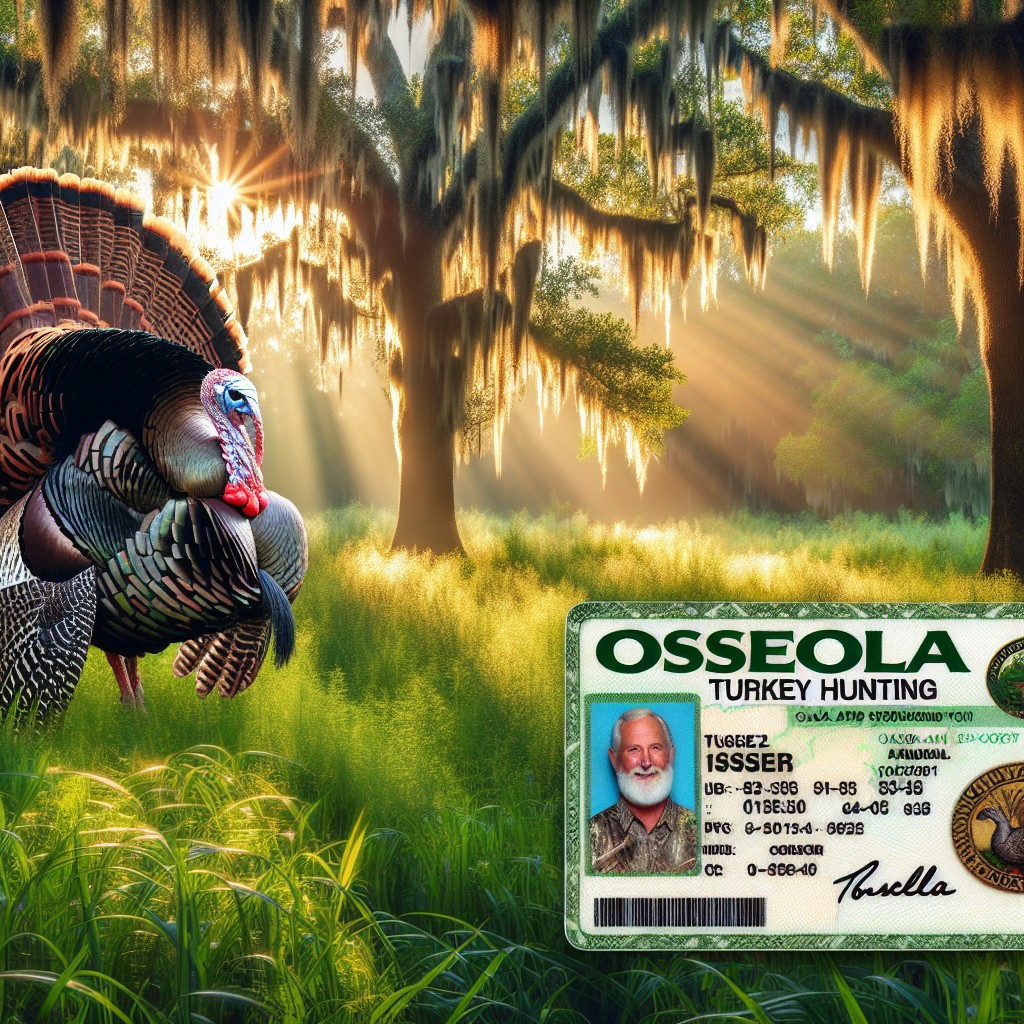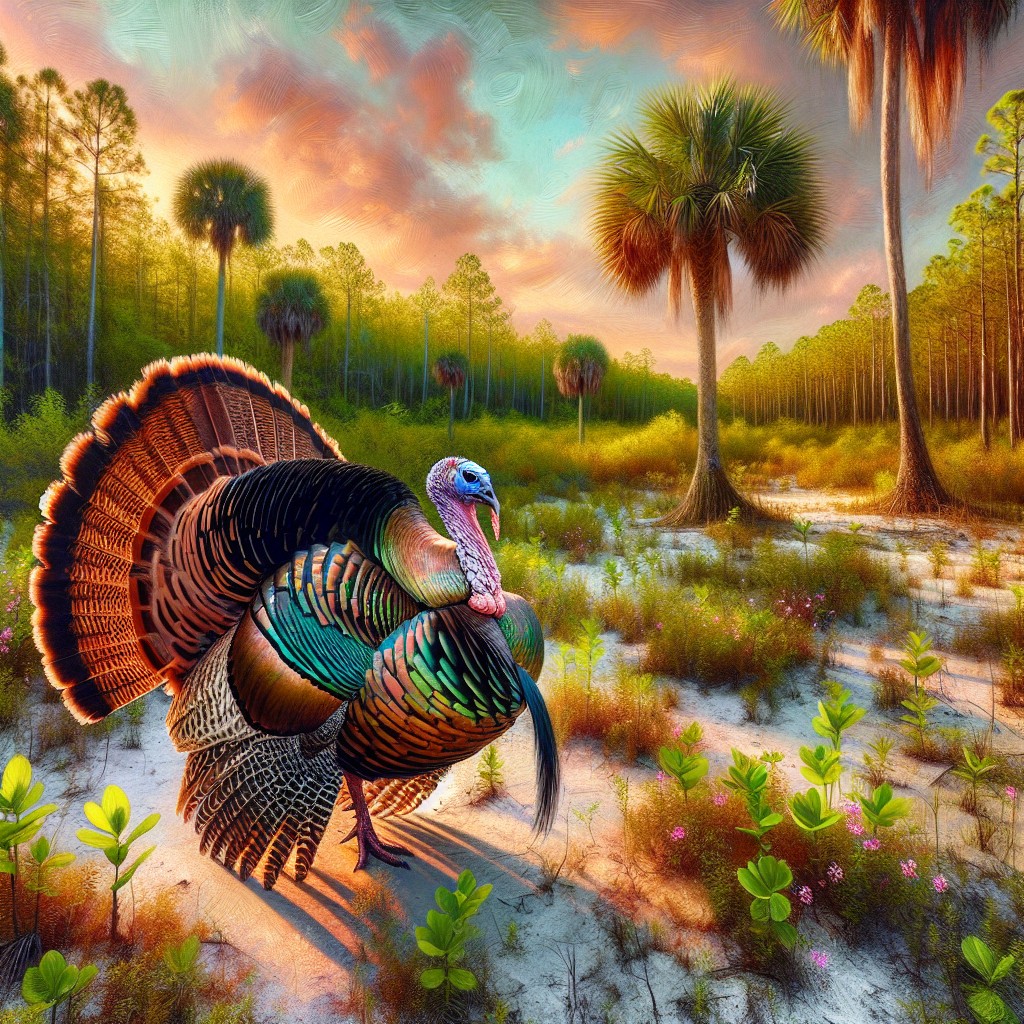Last updated on
Discover the thrill of self-guided Osceola turkey hunts without breaking the bank because this article delivers an in-depth look at the best budget-friendly options available to you.
Embarking on an Osceola turkey hunt without breaking the bank hinges on your ability to navigate the nuances of essential preparations. Whether it’s understanding the intricacies of necessary hunting licenses, pinpointing the optimal public lands that promise an encounter with the elusive Osceola, or honing your turkey calling finesse, each step is a stride towards an affordable self-guided adventure.
Equally crucial is discerning which gear will be your steadfast ally in the wild. This article serves as your compass to cost-effective Osceola turkey hunts, covering every angle from permits to the prowess of a well-placed call, ensuring your quest is both fruitful and financially feasible.
Key takeaways:
- Understanding Osceola Turkey Hunting Licenses*: Get the right licenses and permits.
- Scouting Public Land*: Look for signs of turkey presence.
- Affordable Public Land Permits*: Know the available options.
- DIY Osceola Turkey Calling Techniques*: Master the essential turkey calls.
- Essential Gear*: Invest in quality equipment for a successful hunt.
Understanding Osceola Turkey Hunting Licenses

Before venturing out for your self-guided Osceola turkey hunt, securing the appropriate licenses is paramount. Here’s a breakdown of what you’ll need:
- Florida Hunting License: Mandatory for residents and non-residents. Available online, at county tax collectors’ offices, or from licensed agents.
- Turkey Permit: In addition to your hunting license, a turkey permit specifically authorizes you to hunt turkeys.
- WMA (Wildlife Management Area) Permit: If you choose to hunt in a WMA, this additional permit is required.
- Limited Entry/Quota Permits: Some public lands require these for population management. Apply early, as they are distributed on a lottery basis.
Ensure that you understand the dates when these licenses and permits go on sale, as some can sell out quickly. Also, remember to check if there are any hunter education requirements. Keep all licenses and permits on you during the hunt to avoid fines or legal trouble. Always consult Florida’s Fish and Wildlife Conservation Commission (FWC) for the most current regulations.
Scouting Public Land for Self-Guided Hunts

Successful scouting sets the stage for a triumphant self-guided Osceola turkey hunt. Before venturing out, equip yourself with a property map, often available online through the Florida Fish and Wildlife Conservation Commission or at local outfitters. Start early, as Osceola turkeys are elusive, and securing a prime location is key.
Look for signs of turkey presence such as tracks, feathers, and droppings early in the morning or late afternoon when birds are most active. Identify roosting trees—tall, sturdy trees near clearings—as turkeys often return to the same spot each evening. Additionally, seek out water sources and food-rich areas, as these are hotspots for turkey activity.
Bring binoculars to observe from a distance, minimizing disturbance to their natural behavior. If you’re able to spot birds during preseason scouting, note their patterns. However, avoid over-visiting these areas to reduce the risk of altering their routine.
Digital tools are your allies. Utilize satellite imagery and GPS apps to mark successful scouting areas and navigate back when hunting season opens. Remember, patience and persistence in scouting often pay off in a successful hunt.
Affordable Public Land Permits
Securing an affordable permit is key for the budget-conscious hunter. Florida offers a variety of public land permits that are both accessible and economical. Here’s what to keep in mind:
- Special-Opportunity Permits: While these can be more competitive due to limited availability, they often provide access to prime hunting areas.
- Wildlife Management Area (WMA) Permits: These areas require a permit for turkey hunting, some of which are quota-based, so planning ahead is essential.
- Limited Entry/Quota Hunts: These hunts have a set number of permits to ensure a quality hunting experience and wildlife management.
Remember, the cost of permits can vary, but they are significantly less expensive than guided hunts or leases. Always check the Florida Fish and Wildlife Conservation Commission (FWC) for the most current information on permit pricing and application deadlines. Applying online often provides a quick and easy route to securing your place in the turkey woods.
DIY Osceola Turkey Calling Techniques
Mastering the art of turkey calling is a valuable skill in luring the elusive Osceola, known for their wariness. Begin with the basic yelp, a series of high-pitched sounds that mimic a hen. This call should be clear and rhythmic to grab a turkey’s attention without sounding unnatural. Next, try the cluck — a single, sharp note to pique curiosity. Clucks can be spaced out or delivered in short bursts.
Purr calls serve as a gentle, rolling sound to convey contentment and draw turkeys in with the promise of company. For more aggressive tactics, use the cutting call, a louder series of fast clucks symbolizing excited or agitated turkeys. This can be especially effective during the breeding season when males are more responsive to challenges.
Practice these calls with a box call or slate for easier handling and consistent sounds. YouTube tutorials or local hunting workshops offer practical demonstrations. Familiarize yourself with the nuances of Osceola turkey responses to these calls, as regional variations can affect their effectiveness. Remember to call sparingly to avoid alerting the turkeys to your presence; often, less is more when trying to convince a gobbler that you’re just another turkey in the woods.
Essential Gear for Self-Guided Osceola Turkey Hunts
Packing the right gear is crucial for a successful and enjoyable Osceola turkey hunt. Prioritize a quality shotgun, preferably with a full choke, to ensure a clean ethical harvest. Number 4 to 6 shot turkey loads are effective.
Camouflage is next on the list; opt for patterns that match the subtropical Florida landscape. Don’t forget a face mask and gloves to conceal any exposed skin.
Turkey calls are essential; a variety of calls might be necessary to lure an Osceola, given their wariness. Box calls, slate calls, and diaphragm calls each offer unique sounds that can mimic hen turkeys.
A reliable set of optics, like binoculars, will aid in spotting turkeys from a distance without spooking them.
Comfort is also key. Quality boots will navigate the diverse Florida terrain, from swampy areas to dry oak hammocks. Likewise, a portable seat or cushion offers much-needed comfort during long waits.
Finally, a GPS device or a detailed map of the area can be an invaluable tool for navigation and marking successful spots or turkey sign, ensuring you can find your way safely and efficiently. Always carry a field dressing kit for post-hunt processing and a large enough backpack to transport your gear and any potential harvest.
Seasonal Timing for Optimal Hunting
Zeroing in on the right season can make or break a self-guided Osceola turkey hunt. Understanding Florida’s unique hunting periods boosts your chances of success.
Florida’s spring turkey season typically kicks off in March and ends in April, but exact dates vary by zone, with the southern zones generally opening earlier.
The Osceola subspecies is unique to the state, so it’s crucial to target them when they are most active—during the breeding season when gobblers are calling and strutting.
Mornings are prime times for hunting as turkeys are most vocal and active after roosting at night.
Pre-season scouting can pay off; visit areas a few weeks before opening day to observe turkey behavior and patterns.
Avoid the late season if you can; as the season progresses, turkeys become warier due to increased hunting pressure and may change their routines.
Consider the weather; cooler mornings may lead to increased turkey activity, while hot midday temperatures often cause them to seek shade and become less active.
Pay attention to rain forecasts; light rain can enhance your hunt as turkeys are likely to move into open fields, making them easier to spot.
By planning your hunt around these times, you’ll position yourself at an advantage for encountering the elusive Osceola turkey.
Local Wildlife Regulations and Compliance
Before heading out on a self-guided Osceola turkey hunt, it’s crucial to be up-to-date with the Florida Fish and Wildlife Conservation Commission’s (FWC) regulations. These rules are put in place not just for the hunter’s safety but also to ensure sustainable wildlife populations.
- Season Dates: Make sure you hunt within the designated spring turkey season, specific dates can vary by zone.
- Bag Limits: Know the daily and seasonal bag limits for turkeys to avoid penalties.
- Legal Hunting Hours: Turkeys can be legally hunted only between half an hour before sunrise until sunset.
- Harvest Reporting: After taking a turkey, you must record your harvest on your hunting license and report it to the FWC’s Harvest Reporting System.
- Baiting: Using bait is illegal in turkey hunting. “Bait” is considered any placed food that can lure or attract birds.
- Firearms and Ammunition: Only shotguns, bows, or crossbows are legal; familiarize yourself with the specific requirements for each.
- License and Permits: Carry the proper hunting license and turkey permit at all times while hunting.
Compliance is non-negotiable, and regulations are enforced to protect the resource and maintain a fair chase ethic. It is every hunter’s responsibility to ensure they adhere to these regulations for a lawful and enjoyable hunting experience.
Safety Tips for Solo Turkey Hunters
Emphasize visibility by wearing hunter orange when moving around, as turkeys have poor color vision but excellent detail resolution.
Inform a reliable contact of your hunting plan, including specific locations and expected return time.
Carry a well-stocked first-aid kit to handle minor injuries and emergencies.
Stay hydrated and protected from the elements; consider wearing a hat and applying sunscreen even on overcast days.
Master the identification of turkey calls versus other hunters to prevent accidental incidents.
Inspect gear before heading out, ensuring your firearm is in good working condition and you have the necessary safety equipment.
Keep a fully charged mobile phone with emergency numbers saved, and download offline maps if you’re expecting to be in a zone with limited reception.
Avoid setting up near large tracts of brush or fallen trees to maintain clear visibility and reduce the risk of snake encounters.
Study the behavior of the Osceola turkey to understand when they’re more likely to respond to calling, reducing unnecessary exposure.
Lodging: Camping Vs. Local Accommodations
When planning a self-guided Osceola turkey hunt, the choice between camping and local accommodations will affect both your budget and experience.
Camping can significantly lower costs and enhance the wilderness experience. It also offers flexibility, allowing you to stay closer to your hunting site, which can be particularly advantageous for early morning starts. However, camping requires you to bring additional gear, which might include a tent, sleeping bag, and cooking equipment. Check local regulations for campfire restrictions and wildlife precautions.
Opting for local accommodations provides comfort, security, and often a hot shower after a long day’s hunt. Staying in a motel or a cabin can offer a restorative night’s sleep, integral for the next day’s hunt. Be sure to book in advance during hunting season, as availability can be scarce. In addition to the amenities, you’ll have the chance to interact with fellow hunters and possibly glean valuable hunting insights.
Whether you choose the ruggedness of camping or the hospitality of local accommodations, both will serve as a home base to rest, recharge, and reflect on the day’s adventure. Remember to weigh convenience, cost, and personal preference as you make your decision.
Navigating Transportation Options to Hunting Sites
Maximizing access to remote public lands where Osceola turkeys thrive often means navigating a mix of transportation options.
Consider renting a 4×4 vehicle, if you don’t own one, to handle rough rural roads, ensuring you can reach less accessible hunting grounds.
Explore smartphone apps or GPS devices specifically designed for hunters that include topographic maps and land ownership details to plot your route efficiently.
Review the regulations of the public land you’re hunting on for allowed transportation methods; some areas may permit off-road vehicles, while others might be foot traffic only.
Carpooling with fellow hunters can be a cost-effective and environmentally friendly way to travel, providing an opportunity to share insights on turkey behavior and hunting spots.
If you’re flying in, look for rental agencies near the airport that offer hunter-friendly vehicles and consider bringing compact hunting gear to minimize luggage.
Invest in a lightweight cart or sling to transport your game and equipment if you’re hiking into your hunting site to make your trip out as easy as your trip in.
Pre-trip planning for how to get to and from your hunting site smoothly is an essential step in ensuring your hunting trip is not only budget-friendly but also time-efficient.
Utilizing Online Resources for Hunting Tips
Harnessing digital platforms can significantly improve your hunting game. Start by visiting the Florida Fish and Wildlife Conservation Commission’s website for foundational knowledge, including habitat details and turkey behavior.
Online forums like The Turkey Hunter’s subreddit or Turkey Hunting on HuntingNet.com provide a community experience where you can ask specific questions and get advice from seasoned hunters.
For real-time reconnaissance, explore satellite imagery through apps like onX Hunt to identify potential roosting sites and feeding areas. YouTube also serves as an invaluable visual resource, with countless instructional videos on turkey calling, patterning shotguns, and stealthy movement in the woods.
Lastly, don’t overlook social media groups dedicated to hunting. They can offer up-to-date information about bird activity and land conditions. Engaging in these groups often leads to personal connections and shared tactics that can be particularly useful for self-guided hunts.
Connecting With Local Hunters for Insider Advice
Tapping into the knowledge of seasoned local hunters can significantly enhance your hunting experience. Here are ways to connect and benefit from their expertise:
- 1. Attend local hunting events or conservation club meetings to network.
- 2. Visit nearby hunting supply stores where locals often share information.
- 3. Participate in online forums and social media groups dedicated to hunting in Florida.
- 4. Offer to volunteer with wildlife management efforts as a way to meet experienced hunters.
- 5. Respectfully approach hunters in the field, understanding they may be protective of their spots.
- 6. Ask for advice on specific locations or tactics rather than general hunting spots to receive more detailed guidance.
- 7. Always express gratitude and maintain relationships for future hunting seasons.
Public Land Hunting Etiquette
Respect fellow hunters by maintaining a safe distance away from others already set up in an area. This ensures everyone’s safety and preserves the quality of the hunt.
Leave no trace behind to preserve the natural habitat. Pick up all your trash, including spent shells, and leave the environment as untouched as possible.
Abide by all posted signage and area regulations. This includes any specific rules about baiting, calls, or decoy use.
Steer clear of private property boundaries unless you have explicit permission to hunt there.
Navigate shared access trails and roads with courtesy, especially during early morning or late evening hours when other hunters are likely to be entering or exiting the woods.
Acknowledge that public land is for everyone’s use. Share resources like parking spots and choice hunting spots without monopolizing them.
Cooperate with wildlife officers and land managers. If approached, show your hunting license and answer questions they may have.
Minimize noise to avoid disturbing wildlife and other hunters. This includes keeping your vehicle’s volume low and limiting loud conversations.
By adhering to these guidelines, you contribute to a responsible hunting community and ensure that public lands continue to be a resource for all to enjoy.
Field Dressing and Meat Care On a Budget
Upon successfully harvesting an Osceola turkey, immediate and proper field dressing maintains meat quality and ensures no part of the bird goes to waste. First, fans of the turkey can be preserved by carefully removing them at the base and setting them aside to dry. Next, begin the field dressing process by plucking feathers or skinning the turkey, considering personal preference for cooking.
Efficiently remove the entrails to prevent bacteria growth, starting from the vent up towards the breast. Use a sharp knife and avoid puncturing the intestines to keep the meat clean. Dispose of innards responsibly by burying them well away from your hunting site to avoid attracting predators.
Cooling the carcass quickly is crucial; if hunting near a vehicle, store the bird in a cooler with ice packs. Otherwise, hang the turkey in the shade to allow air circulation. Always have ziplock bags and a cooler handy; this budget-friendly practice extends the freshness of your harvest until you’re ready for processing.
Meat care extends beyond the field. At home, further process your turkey by removing the breasts, legs, and thighs, and store these cuts in the freezer wrapped in butcher paper or vacuum-sealed bags. Investing in a vacuum sealer might have an upfront cost, but it will save money in the long-term by preventing freezer burn and extending the meat’s storage life.
Comparison of Public Lands for Osceola Turkey Hunting
When selecting public lands for your hunting excursion, consider the following:
1. Accessibility: Some areas may be more remote or have restricted access. Check if the land can be reached by vehicle, or if a hike is in order.
2. Population Density: Research recent data on turkey populations in different public lands to gauge where you might have the best chance of encountering Osceola turkeys.
3. Terrain: Different terrains can affect hunt difficulty. Flat, open areas may be easier to navigate than swampy or densely wooded regions.
4. Size of the Area: Larger public lands may offer more hunting spots but could also require more scouting time. Conversely, smaller areas might see more hunting pressure.
5. Water Sources: Osceola turkeys often roost near water. Lands with lakes, rivers, or wetlands may increase your chances of success.
6. Hunting Pressure: Some public lands might be more popular and therefore, crowded. If you’re seeking solitude, look for lesser-known spots or those that require special access permits, limiting the number of hunters.
Evaluating these factors will help tailor your hunt to your preferences, increasing the likelihood of a rewarding experience without breaking the bank.
Remember to always check for any specific rules and regulations that apply to the public land you choose as they can vary significantly from one place to another.
Budgeting for Your Self-Guided Hunt
Having covered the essentials for establishing your hunt, it’s time to talk numbers. For a successful self-guided Osceola turkey hunt, aligning your budget with the necessary expenditures ensures no surprises down the trail.
License and Permits: Factor in the cost of non-resident or resident hunting licenses and any special turkey permits.
Gear: Quality doesn’t always mean costly. Invest in a reliable call, camouflage, and a dependable shotgun, mindful of end-of-season sales and online deals.
Travel: Gas if driving, or look for round-trip flight deals if flying. Remember, Tuesdays and Wednesdays often boast cheaper fares.
Food and Water: Plan and pack food to avoid unnecessary stops. Bulk-buy non-perishables and consider a portable water filtration system.
Lodging: If camping, remember the one-time expense of gear can outweigh multiple stays at a hotel.
Contingency Fund: Set aside a small portion of your budget for unexpected expenses, it’s always better to be over-prepared.
By prioritizing and smartly allocating your resources, your self-guided hunt won’t break the bank. Remember, a well-planned budget is as crucial as a well-aimed shot.
Private Land Turkey Hunts in Florida
While most self-guided hunts focus on public lands for their affordability, private land hunting provides distinct advantages. On private land, hunter competition is significantly reduced, providing a more tranquil hunting experience. Additionally, these areas often have a higher population density of Osceola turkeys, increasing your chances of a successful hunt. Furthermore, some private landowners may offer semi-guided hunts, where local knowledge can be tapped to locate prime roosting spots.
When considering a private land hunt, it’s essential to secure permission from the landowner. In some cases, a nominal fee may be charged for access rights, contributing to your overall hunt cost. Always establish clear guidelines with the landowner regarding the property boundaries and any specific rules or expectations they have for hunters.
Another tip is to seek out farms or ranches that practice wildlife management. These locations may offer a more curated habitat, leading to a richer hunting environment. Always inquire about any conservation practices in place, as these can influence turkey behaviors and patterns.
Lastly, remember that while hunting on private land can offer a more exclusive experience, it’s crucial to maintain a respectful relationship with the landowner. Leave the property as you found it, follow all game laws, and express your gratitude for the opportunity — it might just secure an invitation for future seasons.
Osceola Turkey Hunting Packages/Rates
While self-guided hunts can cut costs, some hunters opt for pre-arranged packages that offer convenience, local expertise, and often access to private lands with higher bird populations. Prices of these packages typically vary based on included amenities. Basic packages may start around $1,200, often covering a guide, access rights, and sometimes meals and lodging. More comprehensive deals might include additional services like calling aid, field dressing, and trophy preparation; these can reach upwards of $2,000.
When considering these options, evaluate what’s included:
- Guide services: Experienced guides can enhance success rates significantly.
- Access to private lands: Private territories may offer less pressured birds.
- Number of hunting days: Typically, a hunt spans three to five days.
- Lodging and meals: Comfort and convenience for hunters coming from afar.
- Transportation: Some packages may include pick-up from nearby airports.
Keep in mind, these are estimated figures and fluctuate based on outfitter, services, and season. Always confirm current rates and specifics before booking. Remember to balance the cost against the potential benefits of local knowledge and exclusive hunting grounds.
Florida Osceola Turkey Season Information
The time frame for hunting Osceola turkeys in Florida is segmented into two primary seasons: the spring and fall. The spring season, which is typically the more popular among hunters targeting this specific subspecies, usually runs from early March through late April. Specific dates can vary by year and by hunting zone, so it’s vital to check the current year’s Florida Fish and Wildlife Conservation Commission (FWC) regulations.
In fall, the opportunity to hunt Osceola turkeys is more limited and generally coincides with the general turkey season, including both gobblers and hens, unlike the spring season which is gobbler-only. The fall dates are shorter and often overlap with other game seasons, again varying by zone.
For those new to the sport or visiting from out of state, youth turkey hunt weekends are also available. These are typically set before the general season opening and are designed to encourage young hunters to learn and participate in turkey hunting under the guidance of a supervisor.
Permits for hunting during these seasons require timely applications, with quota hunts often having application deadlines well in advance. The FWC’s website provides detailed information on application dates, zone specifics, and any changes to the season that hunters should be aware of before planning their hunt.
What Kind of License Is Required to Hunt Turkeys in Florida?
To legally pursue the elusive Osceola turkey in Florida, hunters must secure a proper hunting license which entails a Florida hunting license and a turkey permit.
Non-residents require a non-resident hunting license and a turkey permit as well.
During spring turkey season, a special permit is needed for hunts on some public lands, acquired through a lottery system.
It’s critical to note that these permits are limited to ensure sustainable hunting practices.
Youth hunters get the advantage of the Youth Turkey Hunt Weekend, which requires only a youth hunting license if under supervision by an adult.
For the latest guidelines and fees, consult the Florida Fish and Wildlife Conservation Commission (FWC) website, as regulations are subject to change.
Remember to carry these documents at all times while hunting, as they are your passport to a legal and ethical hunting experience.
FAQ
How much is a guided Osceola turkey hunt?
A three-day fully guided Osceola turkey hunt, with lodging and meals included, costs $3,500.
What area in Florida has the best turkey hunting?
St. Augustine, in Florida, affords the best turkey hunting opportunities, given the diversity of habitats like pine forests and swamps available for wild turkeys during the spring hunting season.
Where do Osceola turkeys like to roost?
Osceola turkeys often prefer to roost in or near water in Cypress or Pine trees, preferably near an opening for easy flight, although this choice may vary due to human pressure and availability.
What is the average weight of an Osceola turkey?
The average weight of an Osceola turkey ranges from 15 to 20 pounds for males and 8 to 12 pounds for females.
What is the best time of year to hunt Osceola turkeys in Florida?
The best time of year to hunt Osceola turkeys in Florida is during the spring season, typically from March to April.
How can a novice hunter increase their chances of catching an Osceola turkey?
A novice hunter can increase their chances of catching an Osceola turkey by learning turkey call techniques, exercising patience when stalking, utilizing effective camouflage, and scouting the bird’s behaviors and habitual patterns beforehand.
What are the specific regulations governing Osceola turkey hunts in Florida?
The specific regulations for Osceola turkey hunts in Florida stipulate that hunting is allowed only during spring turkey season, hunters must have a turkey permit in addition to a hunting license, shooting hours are between 30 minutes before sunrise until sunset, and bag limit is 2 turkeys per season.
Recap




